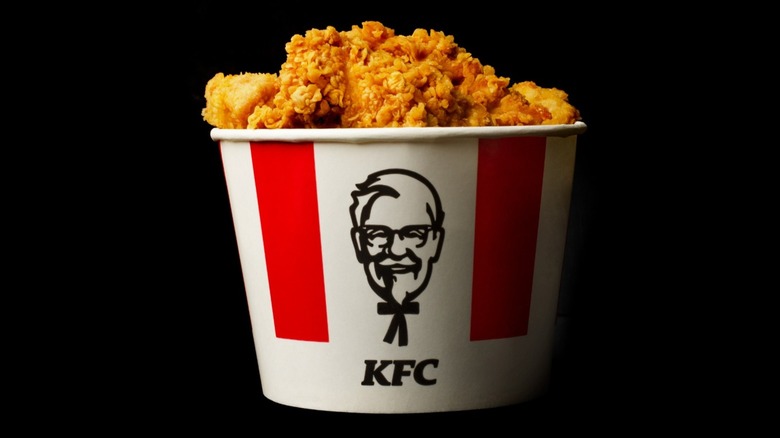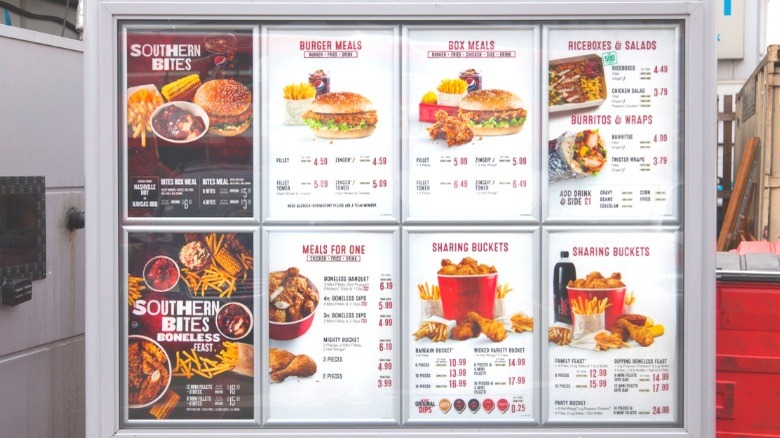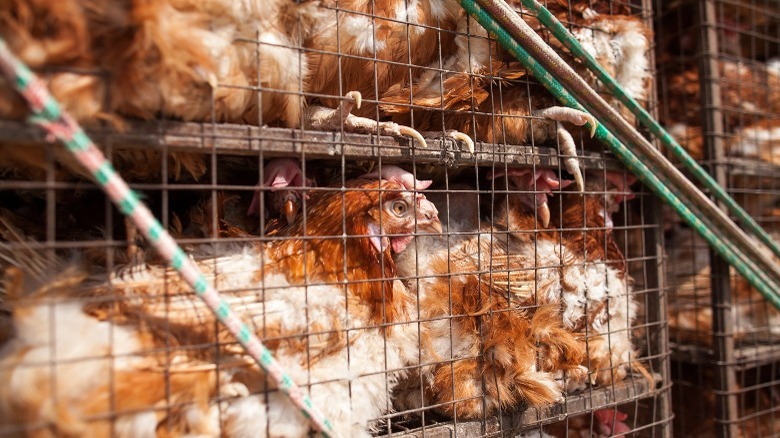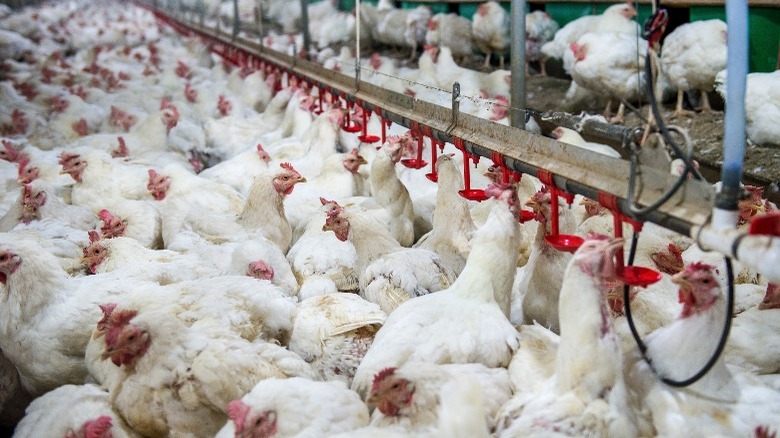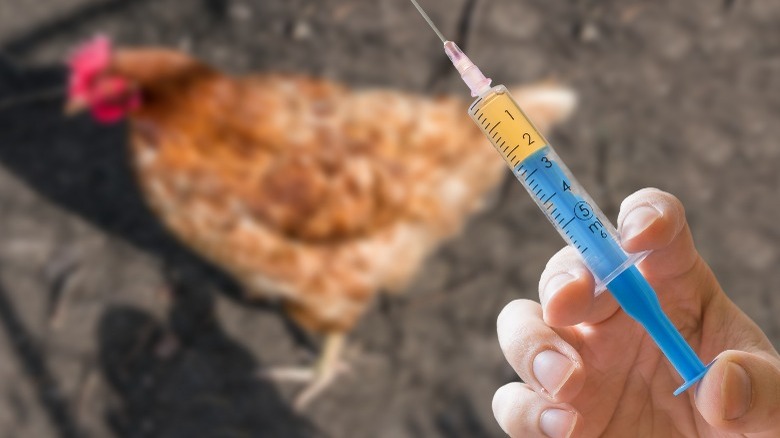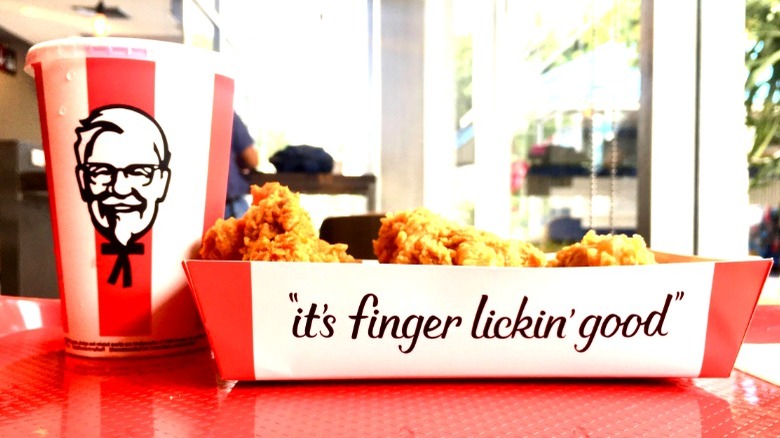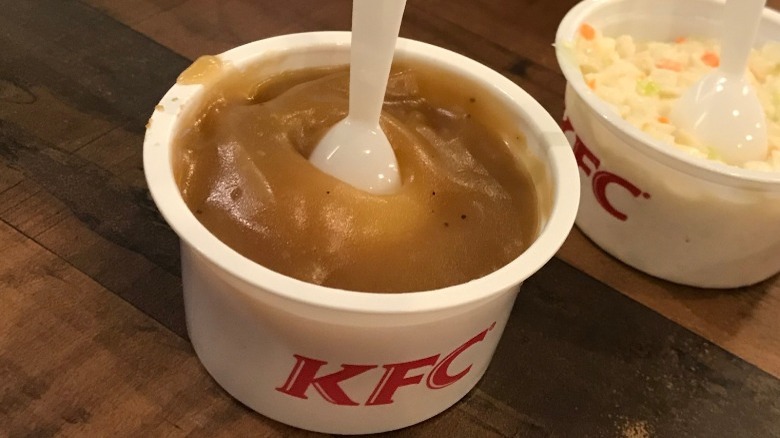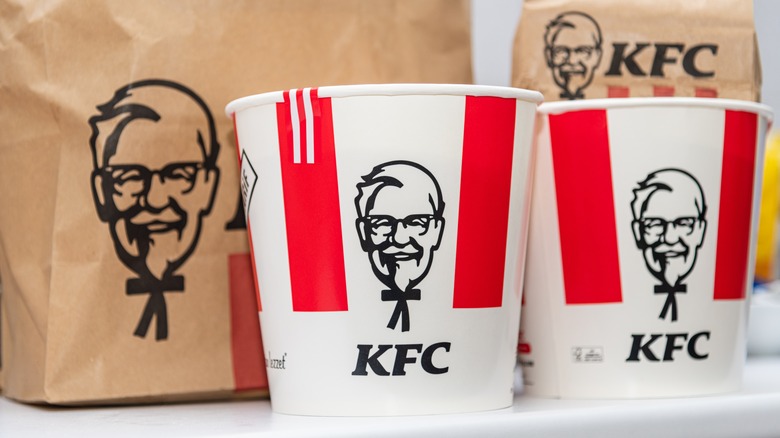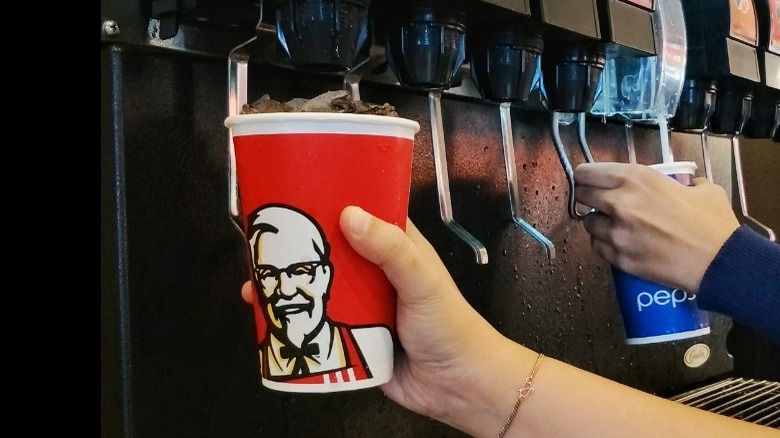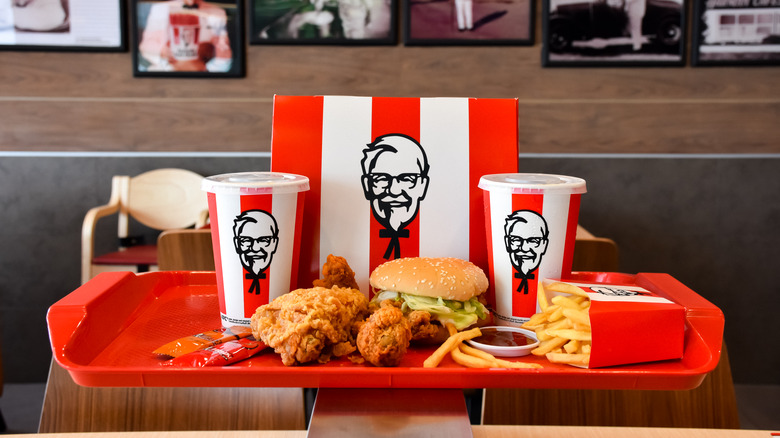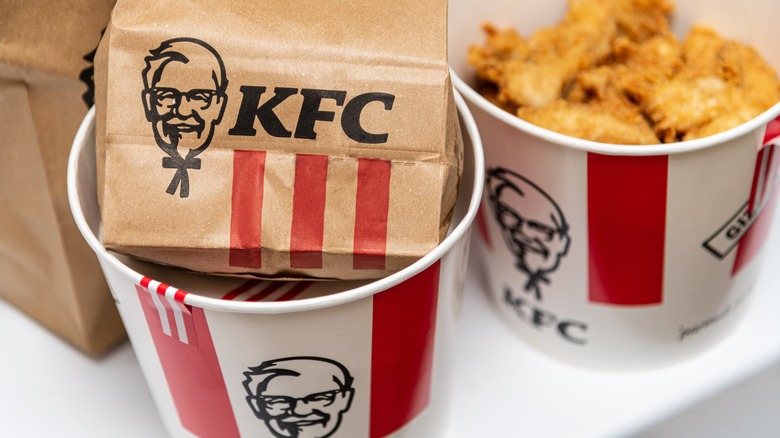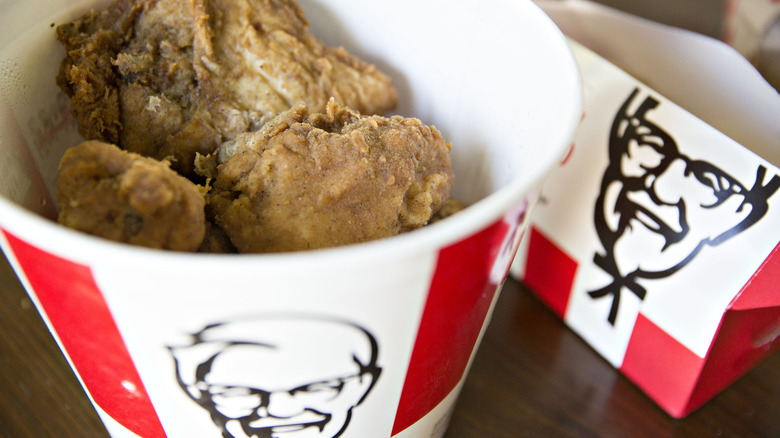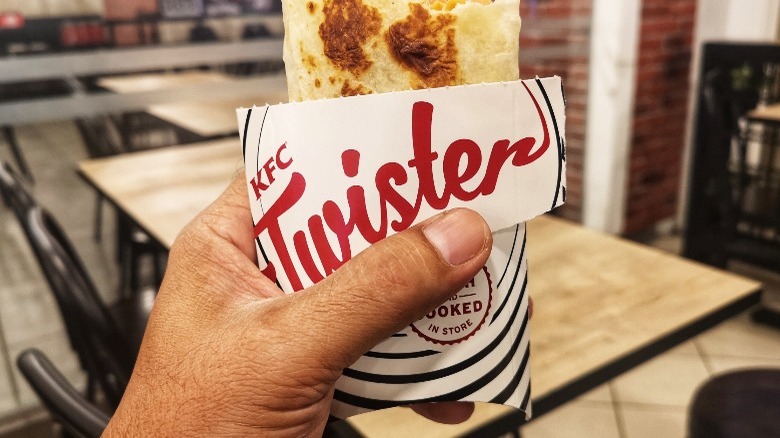Gross Things You Should Know About KFC
Though it ranks as one of the most popular fast food brands in the world, KFC has had its share of gross moments. It's a well-documented legacy, in fact. There are bound to be some nasty happenings from time to time when you operate over 25,000 locations worldwide. None of the various scandals KFC has experienced throughout its decades on the dining scene has permanently marred its reputation, though some have made a memorable impression. Parent company Yum! has also taken plenty of hits from its other companies, including Taco Bell and Pizza Hut. If you're going to serve fast food to millions of people all around the globe, things are bound to get a little disgusting from time to time.
Not all of KFC's grossness comes from scandalous matters, however. Some of the yuck is baked into the secret recipe for success that keeps this fast food chicken kitchen raking in ever-higher revenue year over year. The menu may be tempting, especially when your mood is headed toward hangry territory and you're hankering for a serving of something crisp and tasty. If you've ever paused while downing a three-piece tenders meal or a bucket of wings with a side of mashed potatoes and honey-butter biscuits and wondered what might be occurring behind the counter besides all that deep-fried deliciousness, we've gathered a collection of unsavory tidbits for you to chew on.
Their menu is full of sodium and saturated fat
When you do the nutritional math on KFC's menu items, you come up with some unhealthy calculations. Sodium is found in nearly all of their menu items, with a whopping 1,820 milligrams in a large serving of Popcorn Nuggets, nearly half the recommended daily allowance, according to the FDA. Paired with 1,100 milligrams in a side of fries, your sodium count tops out in a single meal. Then, there's the fat content. A Nashville Hot Extra Crispy chicken breast contains 60 grams, 10 of which are saturated. With Dietary Guidelines of America recommending 22 grams of saturated fat in a 2,200 calorie-per-day diet, there isn't much wiggle room left for the rest of your daily eating. A combo meal could easily represent a full day's worth of these unhealthy ingredients in one sitting.
None of this means that you can't make KFC's food work for you. If you're still on the fence about giving up your fast food favorites, there are healthier options on the menu that let you make more informed choices. You can check out their nutrition guide to find the details.
They've been accused of animal cruelty
KFC serving millions of meals each year means KFC is producing and processing millions of chickens. What does this mean for the animals? It means crowded conditions that aren't always healthy or humane. As the Guardian reported in 2020, the company acknowledged that inflammation of the foot is common among many of their UK-farmed chickens. Some of this stems from the size of the chickens; a "normal" KFC chicken is super-bred to reach its capacity weight in only 30 days, which taxes its physical systems and makes it difficult for the animals to move. Ammonia from waste products can also burn chickens, which then leads to the need for antibiotics. Pretty gross when you realize these animals are meant to enter the food chain.
Per World Animal Protection, petitioners from 10 countries spoke out against the treatment in 2018, which has led to KFC becoming more transparent with how their animals are treated. As the World Animal Protection shared the following year, KFC committed to pursuing more humane chicken farming methods in Europe as part of a larger effort among food providers to prevent cruelty and neglect in the animal food industry. In 2020, KFC announced the company would be implementing a new set of worldwide guidelines for chicken farming practices. But as the Guardian noted in 2022, there's still some debate about the chickens' living conditions.
They process hundreds of millions of chickens a year
Even if their chickens are housed and cared for under the best of conditions, the quantity of chickens destroyed to provide global fast food meals is staggering. Picturing the number of animals needed to stock KFC restaurants around the world conjures a mind-boggling image of endless chickens sharing the factory farmyard.
As for just how many chickens happen to be in these farms? In 2004, PETA estimated over 750 million were killed a year. As the Los Angeles Times reported in 2003, 350 million chickens were slaughtered a year in the U.S. alone. Doing some quick calculations, that equates to 39,954 chickens killed every hour, or 665 chickens killed every minute in America, all for the sake of KFC. If you can imagine the process for preparing these animals to be used as food, then you can probably picture what's happening around the globe in the name of keeping things flowing at the drive thru — not to mention what's left in the farmyard afterward.
They used to treat their chickens with human antibiotics
When cramped conditions cause animal illness on their chicken farms, KFC has used antibiotics as a solution in the past. Per Reuters, they would even inject antibiotics through eggshells and into the eggs of chicks that had yet to hatch. But there are dangers to introducing these medications into the food chain, which has caused the germs they're meant to kill to become drug-resistant, until the antibiotics no longer work on humans. According to a study published in Frontiers in Microbiology conducted by microbiologists who've studied the global impact, the results of this resistance to the current antibiotics are troubling, with many antibiotics becoming useless against bacterial infections they were meant to treat.
This development has reverberated through the medical world and prompted food providers to take action. Though KFC used human antibiotics on their chickens on a regular basis, in 2017, the company pledged to change their practices in order to eliminate the need for antibiotics among their chicken populations, per the AP. In 2019, the NRDC reported they successfully reached that goal.
The pandemic cast new light on the slogan
Sure, it may have sounded like a great idea in 1956 when the phrase was coined by one of the company's restaurant managers. And yes, the "finger lickin' good" slogan may have become a recognizable part of the KFC package, persisting for decades as a brand identifier. But a global pandemic can change the world's perspective on a lot of popular things, and in 2020, KFC was called out for continuing its traditional tagline in a new ad that had just launched in the U.K., with visuals of people repeatedly licking their fingers.
KFC had no way of knowing the details of the global pandemic when they created the ad, but the company wasn't oblivious to the controversy their marketing mistake caused. They dropped both the phrase and the campaign to discourage poor hygiene practices. When the world is being told to wash their hands better and longer, the last thing a company wants to do is encourage people to put their fingers in their mouths. However, as MarketingWeek noted at the time, they picked it back up in a new campaign a year later. And with that, the unsanitary habit was back on the small screen.
The gravy's apparently made from leftover fryer bits
For better or worse, social media has given us a window into the world of fast food, as it did when a TikTok user posted a video of what appeared to be KFC's in-restaurant process for creating gravy (via Daily Mail). The 2020 clip shows bits of overcooked chicken from the bottom of the fryer being transformed through the magic of a water bath and a packet of spices and seasonings into the muddy brown liquid poured over mashed potatoes. According to the Mirror, many viewers took no offense to the process; as one commenter put it, "People getting funny about gravy being made from chicken fat. HOW DID YOU ACTUALLY THINK GRAVY WAS MADE?" However, others said they felt ill after watching the video, vowing never to eat gravy and KFC again.
Not surprisingly, copycat recipes for homemade KFC gravy make no mention of using fryer trash as an ingredient. While creating new food from kitchen waste may seem like a great way to minimize unnecessary throw-aways, recycling fried chicken sludge into savory dinner sauce is best avoided in favor of fresher ingredients that don't inspire gagging noises.
A customer claimed he was served a fried rat
Stories of horrifying alternative meat being used in fast food restaurants have been around probably as long as fast food has. But one particular KFC patron claimed to have positively identified the source of his meal... and based on what he saw in the wrapper, it didn't appear to be chicken. Per ABC News, a Los Angeles-based customer posted to his Facebook page that, after biting into what he thought was a three-piece chicken meal, he looked down to discover he'd been served what looked a heck of a lot like a cooked rat instead. Images of the food in question seemed to suggest a tail underneath the extra-crispy and 11 secret herbs and spices.
Understandably, the rodent-like shape of the product sure raised some eyebrows, prompting an investigation by the company. In a statement provided to ABC News, KFC confirmed that the DNA test indicated the meat in question was chicken after all. So yes, it was nothing more than a super gross fast food myth. It just goes to show that if you eat with your eyes first, you may not be getting the whole story. Still, it doesn't hurt to look before you bite.
Fecal matter has been found in the ice machines
One thing you should never find in a kitchen of any kind is fecal material. When this gross phenomenon occurs, questions naturally arise about the source and how this nauseating substance made its way into the food prep area. And so it was when fecal contaminants were found in the ice machines at several U.K.-based KFC locations. As the Independent reported at the time, samples were taken for inspection from a list of restaurants that included KFCs from across the region, returning results that showed significant levels of fecal coliform bacteria in the ice itself.
Considering the government standard for such contaminants is a hard zero, the results were not just disgusting; they also posed a serious health risk to customers. Per Metro, to address the issue, the ice machines in all U.K. locations were immediately inspected and cleaned, and KFC reinforced its in-restaurant hygiene standards. It goes without saying that when this kind of gross business shows up behind counters in the fast food business, getting it cleaned up as quickly as possible is serious business.
Employees were filmed hosing down chicken
Not everyone adheres to the same standards of cleanliness when it comes to KFC's numerous kitchens, or so a viral video can make it seem. Per the Daily Mail, employees at one location in South Africa were filmed washing a batch of chicken on the concrete floor of a storeroom using a garden hose. An investigation followed and determined that the chicken was intended to be discarded prior to being prepped in the kitchen, and that the items in question had already been breaded with KFC's secret seasoning. The company said in a statement, "We have strict processes in place, even when it comes to food disposal and will not tolerate our stores not following them. We have already dealt very firmly with the owner and responsible people involved."
After the clip went viral, the managers of the company explained the mistake in an apology written in the Sunday World (via Daily Record) and confirmed that the food was indeed headed for the bin, not for the buckets. A picture may be worth a thousand words, but a video is worth at least a full-blown explanation, an apology, and a vow to make sure the same move doesn't happen in the future.
A supplier altered labels on expired chicken
As seriously as KFC may take food safety after issues are discovered, some markets have tested the limits in gross ways that could have made customers incredibly ill. Per the AP (via USA Today), KFC found themselves in a bit of a pickle when a 2014 report revealed that repackaged chicken with "new" expiration dates on the label had been sold to several fast food restaurants in China, including KFC.
The scandal followed a 2013 report regarding excessive use of antibiotics in chickens destined for KFC kitchens, which, as Reuters reported, prompted KFC to cut ties with several distributors. As noted by CNN, this double whammy unsurprisingly led to a massive 13% drop in KFC year-over-year same-store sales in the region. It turns out when people learn about repulsive practices within the restaurant industry, they're less eager to keep eating at the offending restaurants, even when the incident is a mistake— and especially when it isn't. But everyone loves a comeback story, and eventually KFC sales rebounded.
Someone found a fried chicken head in her hot wings
From the "Um, This Isn't What I Ordered ... " file: Per The Sun, a U.K. customer once opened her box of KFC hot wings to find an intact chicken head complete with beak and eyes lying breaded and fried among the other pieces, a situation the word "gross" doesn't even begin to cover. The customer posted a photo of the offending head along with her two-star JustEat review of the restaurant. She included the comment, "Put me off the rest of my meal, urgh," which may be the understatement of the century. "What does it take to get one star?" asked one commenter, which is a follow-up question that no one can fault.
As The Sun noted, even KFC commented that a two-star rating was more than generous. They also reached out to the customer to apologize for the experience and to offer her free KFC as a token of their remorse (and to, you know, encourage her to give them another shot). Evidently, it's hard to shake the loyalty of a KFC fan.
A salmonella-tainted wrap caused a severe infection
When it comes to the gross things KFC has in its history, there are some that have led to more than just bad reviews and viral videos. As reported in the Financial Post, one of the more serious gross incidents led to a tragic situation involving a family and a large financial court ruling against the company. Monika Samaan was seven years old in 2005 when she ate a Twister wrap suspected to be tainted with salmonella at a KFC near Sydney, Australia. She, her parents, and her brother were all hospitalized following the meal.
While her family recovered, Samaan's resulting infection left her with brain damage and rendered her wheelchair bound. In April 2012, KFC was ordered to pay the family $8 million Australian dollars, or $8.3 million U.S. dollars, in damages and court costs. Though KFC executives admitted the tragedy of the situation, they were also surprised by the ruling and appealed, though according to Franchisee Business, their appeal was eventually dismissed and the company was forced to pay the amount.
